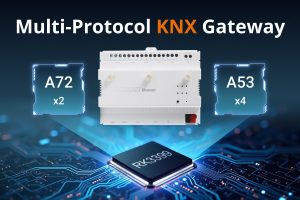1. Introduction
DSM-102 ZWAVE Module is a low power-consuming embedded ZWAVE module developed By Dusun IoT. It consists of the highly integrated wireless radio processor chip, ZGM130S037HGN1, and several peripherals, with a built-in ZWAVE protocol stack and robust library functions.
This data terminal device is embedded with the high-performance 32-bit 39 MHz ARM Cortex®-M4 CPU with DSP instructions and floating point unit for efficient signal processing, 512 KB flash memory, 64 KB RAM data memory, and robust peripheral resources. It is mainly used for Z-wave gateway coordinators.
- High-performance 32-bit 39 MHz ARM Cortex®-M4 with DSP instructions and floating point unit for efficient signal processing
- Up to 512kB Flash programming memory
- Up to 64kB RAM data memory
- Working voltage: 1.8 V to 3.8 V
- BLE operating feature
- Supporting 915MHz and 865MHz with an air interface, rate of 100Kbps
- Maximum output power: +13.5 dBm; dynamic difference of output power: > 43 dB
- Dimension: 17 x 22 x 2.8 mm
- Working temperature: –40°C to +85°C
- Certification CE, FCC, SRRC
- Intelligent Building
- Intelligent Home And Household Applications
- Industrial Wireless Control
- Intelligent Public Traffic
2. Mechanical Requirement
DSI-0177-AMBER-ZWAVE provides two rows of pins(2 * 14) with the pin pitch of 1.27±0.1mm
Dimensions: 17±0.35 mm (W) x 22±0.35 mm (L) x 2.8±0.15 mm (H).

| Pin Number | Symbol | IO Type | Function |
|---|---|---|---|
| 1 | GND | P | Power supply reference ground pin |
| 2 | ANT | RF | RF signal input/output port, which corresponds to ANT of IC |
| 3 | GND | P | Power supply reference ground pin |
| 4 | NC | Not connect | |
| 5 | NC | Not connect | |
| 6 | PD13 | I/O | Corresponding to PD13 of IC |
| 7 | PD14 | I/O | Corresponding to PD14 of IC |
| 8 | PD15 | I/O | Corresponding to PD15 of IC |
| 9 | PB11 | I/O | Corresponding to PB11 of IC |
| 10 | PB12 | I/O | Corresponding to PB12 of IC |
| 11 | PB13 | I/O | Corresponding to PB13 of IC |
| 12 | PB14 | I/O | Corresponding to PB14 of IC |
| 13 | PB15 | I/O | Corresponding to P15 of IC |
| 14 | NC | Not connect | |
| 15 | NC | Not connect | |
| 16 | NC | Not connect | |
| 17 | PF3 | I/O | Corresponding to PF3 of IC |
| 18 | PF2 | I/O | Corresponding to PF2 of IC |
| 19 | NC | Not connect | |
| 20 | GND | P | Power supply reference ground pin |
| 21 | VCC | P | Power supply pin (3.3V) |
| 22 | RX0 | I | Corresponding to internal RXD0 of IC |
| 23 | TX0 | O | Corresponding to internal TXD0 of IC |
| 24 | SWDIO | I/O | Corresponding to internal SWDIO of IC |
| 25 | SWCLK | I/O | Corresponding to internal SWCLK of IC |
| 26 | PC11 | I/O | Corresponding to PC11 of IC |
| 27 | PC10 | I/O | Corresponding to PC10 of IC |
| 28 | nRESET | I | Hardware reset pin, which is at a high level by default and is active at a low level |
- P indicates power supply pins, I/O indicates input/output pins
3. Electrical parameters
| Parameter | Description | Typical value |
Minimum value | Maximum value | Unit |
|---|---|---|---|---|---|
| Ts | Storage temperature | -40 | 85 | ℃ | |
| VCC | Power supply voltage | -0.3 | 3.8 | V | |
| Static electricity voltage (human body model) | TAMB-25℃ | - | KV | ||
| Static electricity voltage (machine model) | TAMB-25℃ | - | KV |
| Parameter | Description | Minimum value | Maximum value | Typical Value |
Unit |
|---|---|---|---|---|---|
| Ta | Working temperature | -40 | 85 | -25 | ℃ |
| VCC | Power supply voltage | 1.8 | 3.8 | 3.3 | V |
| VIL | I/O low-level input | - | I0VDD*0.3 | V | |
| VIH | I/O high-level input | I0VDD*0.7 | - | - | V |
| VOL | I/O low-level output | - | I0VDD*0.2 | - | V |
| VOH | I/O high-level output | I0VDD*0.8 | - | - | V |
| Working status | Type | TX Power/ Receiving | Typical value | Average value |
Unit |
|---|---|---|---|---|---|
| TX | F=868.4MHZ CW Mode | +13dBm | 40.7 | mA | |
| TX | F=908.4MHZ CW Mode | +4dBm | 17.9 | mA | |
| TX | F=908.4MHZ CW Mode | +0dBm | 9.8 | mA | |
| RX | 100kbps 2GFSK,F=869.85MHz | Constant receiving | 9.6 | mA | |
| RX | 40kbps,2FSK,F=868.4 | Constant receiving | 8.8 | mA | |
| RX | 9.6kbps,Manchester,2FSK,F=868.42MHZ | Constant receiving | 9.1 | mA | |
| RX | Constant receiving | 9.9 |
4. RF features
| Parameter | Description |
|---|---|
| Frequency band | 868 MHz Band & 915 MHz Band |
| Wi-Fi standard | ZWAVE |
| Data transmission rate | 100kbps max |
| Antenna type | PCB antenna with a gain of 1dBi. IPEX (optional) |
| Parameter | Minimum value | Typical value | Maximum value | Unit |
|---|---|---|---|---|
| Maximum output power | 4 | - | 10 | dBm |
| Minimum output power | - | -30 | - | dBm |
| Output power adjustment step | - | 0.5 | dBm | |
| Output spectrum adjacent-channel rejection ratio | -49 | -47 | -30 | dBc |
| Frequency error | -15 | - | 15 | ppm |
| Parameter | Minimum value | Typical value | Maximum value | Unit |
|---|---|---|---|---|
| PER<1%, RX sensitivity(Zigbee 250Kbps) | -102.6 | - | -97.5 | dBm |
5. Antenna
This product uses an onboard PCB antenna or IPEX.
To ensure optimal RF performance, it is recommended that the antenna be at least 15 mm away from other metal parts. If metal materials are wrapped around the antenna, the wireless signals will be reduced greatly, deteriorating the RF performance.
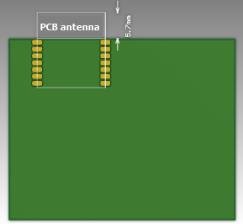
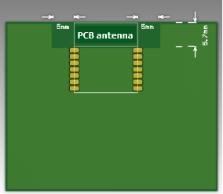
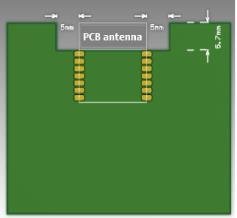
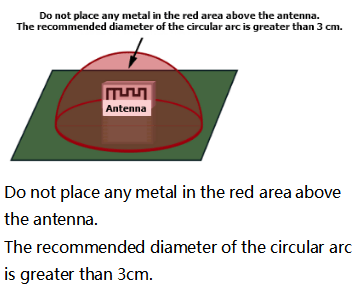
7. Production instructions
1. Use an SMT placement machine 0t0o0 mount components to the stamp hole module that DUSUN produces within 24 hours after the module is unpacked and the firmware is burned. If not, vacuum packs the module again. Bake the module before mounting components to the module.
- SMT placement equipment:
- Reflow soldering machine
- Automated optical inspection (AOI) equipment
- Nozzle with a 6 mm to 8 mm diameter
- Baking equipment:
- Cabinet oven
- Anti-static heat-resistant trays
- Anti-static heat-resistant gloves
- The moisture-proof bag is placed in an environment where the temperature is below 30℃ and the relative humidity is lower than 70%.
- The shelf life of a dry-packaged product is six months from the date when the product is packaged and sealed.
- The package contains a humidity indicator card (HIC).

- If the 30%, 40%, and 50% circles are blue, bake the module for 2 consecutive hours.
- If the 30% circle is pink, bake the module for 4 consecutive hours.
- If the 30% and 40% circles are pink, bake the module for 6 consecutive hours.
- If the 30%, 40%, and 50% circles are pink, bake the module for 12 consecutive hours.
- Baking temperature: 125±5℃
- Alarm temperature: 130℃
- SMT placement ready temperature after natural cooling: < 36℃
- Number of drying times: 1
- Rebaking condition: The module is not soldered within 12 hours after baking.
Electroless nickel immersion gold (ENIG) is used for the PCBs. If the solder pads are exposed to the air for over three months, they will be oxidized severely and dry joints or solder skips may occur. Roombanker is not liable for such problems and consequences.
Perform SMT placement based on the following reflow oven temperature curve. The highest temperature is 245℃.
Based on the IPC/JEDEC standard, perform reflow soldering on a module at most twice.
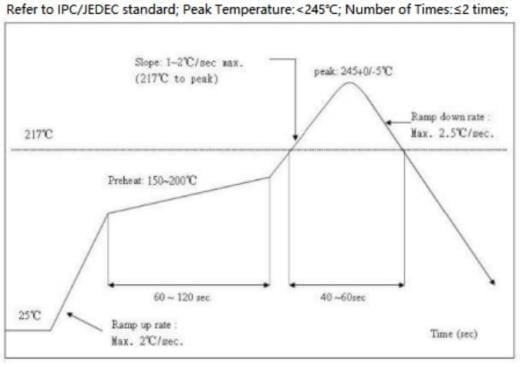
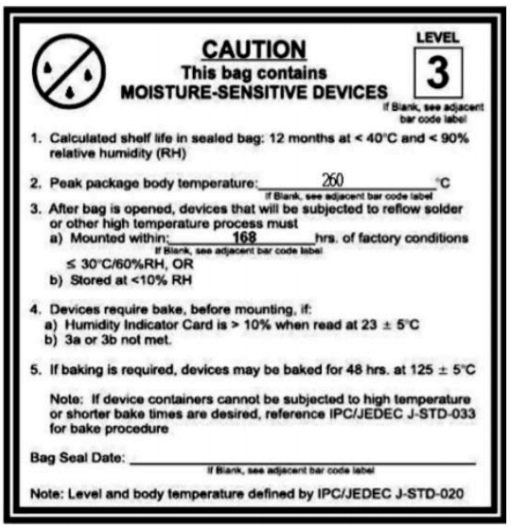
8. MOQ and packing
| Product model | MOQ(pcs) | Packing method | Number of Modules in each reel pack | Number of reel packs in each box |
|---|---|---|---|---|
| DSI-0177-AMBER-ZWAVE | 4000 | Carrier tape and reel packing | 1000 | 4 |

















